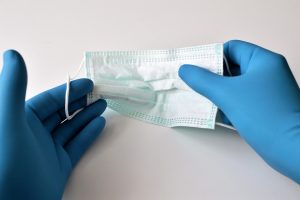China is stepping up virus inspections on imported food packaging as cooler weather brings new waves of coronavirus infections in several overseas countries, Chinese officials said Wednesday.
Packaging is “not exempt” from carrying the virus, deputy director of the National Food Safety Risk Assessment Center Li Ning told reporters.
While the coronavirus positivity rate for tests on packages was just 0.48 per 10,000, that proportion is increasing along with the number of tests being conducted, Li said.
She said the virus could “to some extent” be passed to humans from packaging, although neither Li or any other official at Wednesday’s news conference mentioned any such confirmed cases.
Chinese testing of packaging has stirred some controversy, with exporters of frozen food items questioning the science behind it and whether it amounts to an unfair trade barrier. China has defended the practice as an additional measure to prevent the virus’ spread.
China’s focus on imported food comes as Chinese state media outlets continue to promote the narrative that COVID-19 did not originate in Wuhan, where the virus was first detected. Instead, some Chinese scientists have claimed – without evidence thus far – that the coronavirus could have been brought to Wuhan through frozen food imports. That was the theory put forward by the chief epidemiologist of the Chinese Center for Disease Control and Prevention at an online conference on November 19.
The Global Times likewise reported that “top Chinese experts have also suggested that the possibility cannot be ruled out that the Wuhan outbreak was also caused by international cold-chain deliveries.”
China’s current emphasis on frozen food imports as a vector for COVID-19 thus takes on political dimensions, as it seems to be a key part of the Chinese claim that the virus did not originate on its soil.
The World Health Organization is currently conducting an investigation into the origins of COVID-19, but has been criticized for letting researchers in China take the lead. The WHO’s team of international researchers is tasked with designing long-term studies based on initial findings from Chinese scientists. An in-depth New York Times investigation earlier this month outlined how the WHO was stymied from investigating the origins of COVID-19 starting from the early stage of the outbreak.
Through mask mandates, mass testing, lockdowns, and case tracing, China has largely eliminated cases of local transmission, causing it to place extra attention on infection threats from outside the country. China’s National Health Administration on Wednesday reported five new cases, all imported, bringing China’s total to 86,469, including 4,634 deaths.
Stopping the virus’s spread is “like fighting a war,” demanding fast, decisive action, CDC Chief Epidemiologist Wu Zunyou said.
“Victory only comes after the entire country is united in its efforts. On this front, technical strategy, strong leadership and coordinated action all play important roles,” Wu said.
The coronavirus is known to be more stable in colder, dryer conditions, and disinfecting packaging at freezing temperatures creates “special challenges,” said Zhang Liubo, chief disinfection officer for the Center for Disease Control.
Even when disinfection works and the virus is no longer infectious, remnants can remain on the packaging, leading to a positive test, Zhang said.
However, “as of present, we have yet to discover any infection caused by direct consumption of products from this cold chain,” Zhang said.
By the Associated Press, with additional reporting from The Diplomat.

































